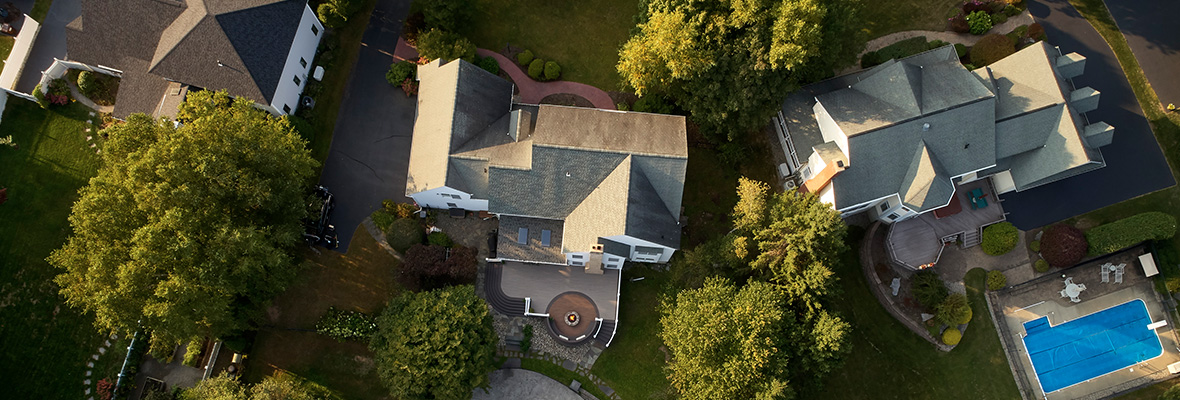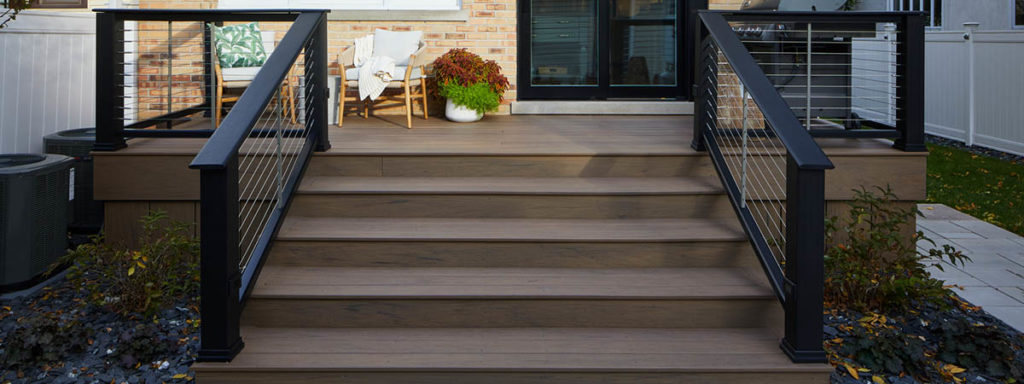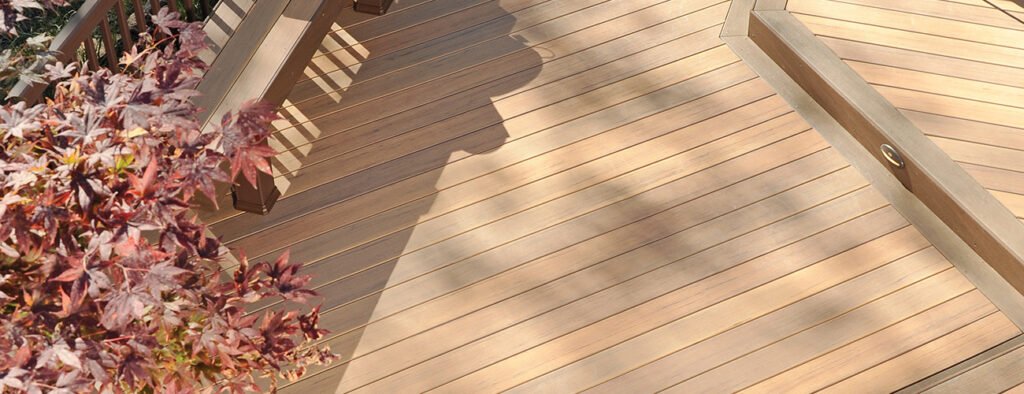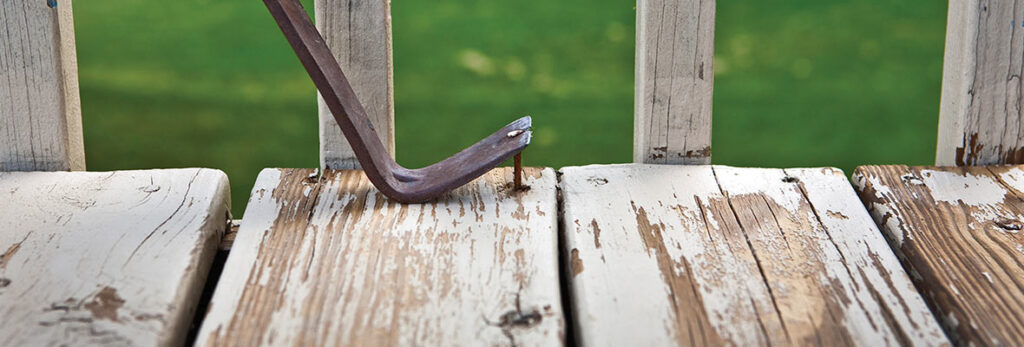Your home is one of the largest investments you’ll ever make, and you’ll have to continue to invest time and money to maintain its health, value, and integrity. From deck maintenance to appliance inspections, our home maintenance checklist will help you stay on top of your tasks for a home that lasts.
TimberTech Tip:
• Winter: best for interior upgrades
• Spring: best for cleaning and inspections
• Summer: best for lawn and garden updates
• Fall: best for winter preparations
In This Article:
- Winter maintenance
- Spring maintenance
- Summer maintenance
- Fall maintenance
- Monthly maintenance
- Appliance maintenance
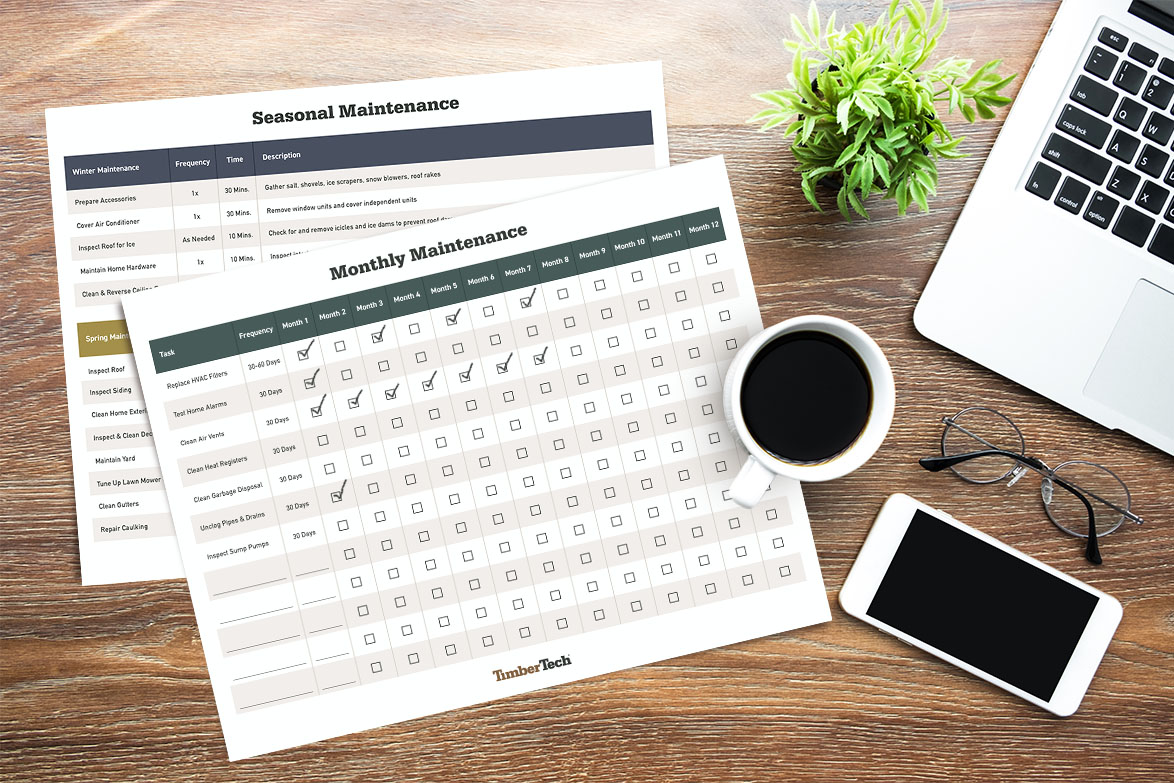
Download Home Maintenance Checklists
Winter home maintenance
The new year offers a fresh start for you and your home, while the winter season brings a couple of additional chores to your maintenance schedule. Below are the tasks that get you through winter and keep your home healthy and warm.
- Prepare winter accessories
- Cover air conditioners
- Inspect for ice
- Maintain home hardware
- Reverse ceiling fans
Prepare winter accessories
Winter brings ice and snow to many decks and driveways, creating a hazard for you and your property. Prepare for the season before the bad weather rolls in and gather the appropriate accessories for your area, which may include:
- Snow shovels
- Snow blowers
- Ice scrapers
- Roof rakes
- Ice melt salt
Inspect your equipment to make sure everything is ready for the first big snow now, so you’re not waiting in line at the hardware store when it hits.
Benefits: preventative maintenance
Time cost: 30 minutes
Actual cost: $0+
Cover your air conditioner
It’s unlikely you’ll need to turn up the AC during the chilly winter months, so it’s best to cover them. Most freestanding units are designed to withstand snow and ice, but excessive exposure can damage the AC coils over time. Covers cost as little as $20, which is much cheaper than repairing a damaged unit, and you’ll extend the life of your HVAC.
Window units should be removed and put away for the season, but you can leave them installed if there are no drafts or air leaks. In this case, it’s still a good idea to get a cover so you know you’ll have cool air when the weather warms.
Benefits: preventative maintenance
Time cost: 30 minutes
Actual cost: $20+
Inspect your roof for ice
Ice accumulation on your roof can cause serious property damage if it’s left unchecked. Sliding ice can also cause personal damage or harm nearby structures like your deck or vehicles. Regularly check your roof for icicles and ice dams and remove ice with a roof rake to avoid accidents.
Benefits: preventative maintenance
Time cost: 10+ minutes
Actual cost: $0
Maintain your home’s hardware
Home hardware is easy to overlook but benefits from regular inspections and maintenance. Check out your interior hinges, handles, and door knobs for damage or improper movement. Hardware may need to be oiled or polished, and fasteners may need tightening to improve function.
Benefits: preventative maintenance
Time cost: 10+ minutes
Actual cost: $0
Clean and reverse your ceiling fans
Ceiling fans turn both clockwise and counterclockwise to accommodate the changing seasons. You can find a switch at the base of the fixture to reverse the fan blade direction. In the winter, your fan should turn clockwise to push hot air back down and keep your room warm.
Be sure to thoroughly dust and clean your fan blades before you turn it back on. Otherwise, all of the dust that’s accumulated from the last season will blow across your room when the fan spins in the opposite direction.
Benefits: preventative maintenance
Time cost: 5 minutes
Actual cost: $0
Spring home maintenance
When winter snow finally melts and flowers start to bloom, you know it’s time for a little spring cleaning. This seasonal home maintenance checklist is longer than other seasons, as you prepare your yard for fresh growth and inspect your home after the harsh winter:
- Inspect roof and siding
- Clean your home exterior
- Inspect and clean your deck
- Maintain the yard and garden
- Tune up your mower
- Clean your gutters
- Repair caulking
Inspect your roof and siding
The warming weather is a great chance to walk around your property and inspect your home’s exterior. Look for damaged siding or loose shingles and repair them as needed. Roofs often need to be replaced every 15-30 years, while home siding will need to be replaced in 20-40 years, depending on your material choice. Some manufacturers, like AZEK Exteriors, guarantee their siding’s long-lasting quality with a Lifetime Limited Warranty.
Benefits: preventative maintenance
Time cost: 15 minutes
Actual cost: $0
Deep clean your home’s exterior
Once you’ve repaired any damages, it’s time to break out the soap and pressure washer to clean your home’s exterior.
Siding collects dirt, mildew, and pollen year-round. Most siding can be cleaned with a pressure washer or stiff brush and dish soap. However, it varies among materials and manufacturers, so you should always consult your manufacturer’s care instructions before starting to scrub.
Your windows and screens also collect dirt, which need to be cleaned to enjoy a fresh breeze and crystal-clear view. You can clean both with a water hose or invest in specialty cleaning supplies, like window screen brushes.
Don’t skip your driveway and sidewalks. Your pavement may not look too bad until you start clearing all of the dirt and mildew with a pressure washer. Once you’re reminded of its original color, you’ll love how fresh and clean your home is from curb to curb.
Benefits: preventative maintenance and clean appearance
Time cost: 1+ hour
Actual cost: $0-$35*
*Cost to rent a pressure washer
Inspect and clean your deck
Homeowners should inspect their decks annually for mold and mildew, splintering wood, or loose fasteners. Composite deck owners don’t have to worry about splinters, but you should still clean your deck once or twice a year with deck cleaner and proper brushes. Consult your manufacturer’s guidelines for cleaning instructions.
If you own a wood deck, you also need to reseal it every one to three years. Sealing and waterproofing a wood deck costs around $350 a year and varies based on your sealer needs and deck size.
Benefits: preventative maintenance and clean appearance
Time cost: 1+ hour
Actual cost: $0-$350
Maintain your yard and garden
Prepare your garden for new growth this spring with a little yard maintenance. Start by clearing remaining leaves and debris from your yard and garden beds.
Add fresh mulch to flower beds and hedges, and replace your landscaping fabric and edging where necessary. Fresh fertilizer in your yard and garden will also kick-start growth.
Trim hedges and overgrown tree limbs to prevent damage from spring showers. Keep an eye out for damaged or diseased branches that pose extra risk, and consider hiring a professional for large trees or those near power lines.
Benefits: improved lawn appearance and growth
Time cost: 1+ hour
Actual cost: $0-$100*
*Cost for mulch and fertilizer
Give your lawn mower a tune-up
Inspect and service your lawn mower annually for a well-manicured lawn. Replace the air filter, spark plug, and oil as part of your annual maintenance. You should also sharpen mower blades every 20-25 hours of use for the best cut.
Benefits: improved appliance efficiency
Time cost: 1+ hour
Actual cost: $50-$200
Clean your gutters
Cleaning your gutters twice a year helps prevent backup and damage to your gutters and downspouts, which prevents excessive water exposure to your home and foundation. Spring is a great time to remove leaves and debris and inspect your gutters for any new damage from heavy ice and snow.
Benefits: preventative maintenance
Time cost: 1+ hour
Actual cost: $0-$10
Repair damaged caulking
Caulk lasts about five years before it needs to be replaced, and there’s a good chance you have no idea how old the caulking on your tub is. Annually inspecting caulk can help you catch air and water leaks before they’re a problem. Check caulk around your sinks, bathtubs, toilets, windows, baseboards, and counters.
Benefits: improved insulation
Time cost: 1+ hour
Actual cost: $0-$50
Summer home maintenance
Summer is the time to get outside, host barbecues, and enjoy all that outdoor living has to offer. Taking care of a few home maintenance to-dos early in the season lets you enjoy more long summer days without extra chores:
- Maintain your garage
- Prevent insects
- Reverse ceiling fan
- Clean and open your pool
- Inspect irrigation
Inspect and maintain your garage
Garages need a little TLC, too, so don’t forget to sweep the floor and organize your tools. Inspect your garage door for damage or rust, and oil the opener, chain, and door hinges as necessary. If you have plumbing for a sink or washer, check out the caulk and drains for damage to prevent any potential leaks.
Benefits: preventative maintenance
Time cost: 30 minutes-1 hour
Actual cost: $0-$15
Invest in insect prevention
Summer is the peak season for pests, so it’s a good time to look for and repair any cracks around windows or doors where bugs may slip in. You should also move firewood, yard debris, or water features that may attract insects away from your home.
Once the perimeter looks secure, treat your yard and home with the pest prevention method of your choice. Costs and treatments vary significantly between pests, so consult a local professional to learn more.
Benefits: preventative maintenance
Time cost: 30 minutes-1 hour
Actual cost: $200-$600
Dust and reverse your ceiling fans
Once the warmer weather moves in, it’s time to reverse your ceiling fans to spin counterclockwise to circulate cool air. Remember to clean the blades before you turn your fan on to avoid spreading dust around your home.
Benefits: improved efficiency and air quality
Time cost: 5 minutes
Actual cost: $0
Clean and open your pool
Summer is for swimming, so if you have a pool, it’s time to remove the cover and give it a fresh clean. Scrub the walls, test the water, and treat your pool appropriately. You’ll also want a weekly maintenance checklist to skim and treat the water, while the walls should be scrubbed monthly to prevent algae growth.
Benefits: preventative maintenance
Time cost: 1 hour
Actual cost: $115/month
Perform an irrigation inspection
Exterior faucets and sprinklers are exposed to the elements, including dirt, rain, flooding, and wildlife. Ensure everything’s working properly with an annual inspection.
Look for cracks and leaks that may need to be repaired, and clear debris from faucets and irrigation heads. Inspect valves to ensure a strong seal and replace them as necessary.
Benefits: preventative maintenance
Time cost: 1 hour
Actual cost: $0-$15
Fall home maintenance
Just as spring is a good time to clean up after winter, fall is the season to prepare for it. These house tasks will ensure your home and family are ready for the first freeze:
- Clear leaves
- Insulate pipes and exterior faucets
- Close your pool
- Insulate entrances
- Inspect and sweep your fireplace
- Check your water heater
- Clean your gutters
Clear leaves and yard debris
Watching leaves change colors in the trees is one of the earliest signs of fall, and soon they’ll make their way onto your yard and garden. Removing leaves and yard debris throughout the season will help your lawn bounce back to life come spring. Light leaf cover is fine, but if it covers more than 20% of your yard it may smother your grass or cause mold. Leaves can also stain your driveway or decking.
Leaves can be disposed of according to your city’s regulations, or added to a compost pile for easy disposal. You can also mulch with a mower so the leaves fertilize the yard rather than harm it. Mulched leaves and light cover can even prevent weeds.
Benefits: preventative maintenance
Time cost: 1 hour
Actual cost: $0
Insulate pipes and exterior fixtures
Pipes and faucets are prone to crack or burst when the cold dips below freezing, so you have to insulate them to prevent damage. First, shut off water flow to exterior faucets, wells, and irrigation. Then install insulation to protect them throughout the winter. Insulation is easy to find at hardware and home improvement stores.
Your home’s pipes are also vulnerable to extreme cold, so insulate your basement and attic pipes and fixtures, too. Maintain a minimum internal temperature of 55°F to avoid pipe damage in your home.
Benefits: preventative maintenance
Time cost: 1 hour
Actual cost: $0-$10
Close your pool
Once you’re done with pool parties for the season, it’s time to scrub, close, and cover it. Start with your normal cleaning routine and test the pool water. Then, treat it with winterizing chemicals according to your pool’s care instructions.
Once the water is treated, clean the filter, clear the plumbing lines, and remove the pump for the winter. If you have an in-ground pool, lower the water level a few inches below any skimmers and decorative tiles to prevent damage. Cover the pool and you’re done. You can also hire a professional to close your pool for $150-$400.
Benefits: preventative maintenance
Time cost: 2 hours
Actual cost: $150-$400
Insulate door and window entrances
Insulation is key to staying warm and saving costs on your energy bill. Windows and doors are prone to air leaks, so walk around your home’s perimeter and check for drafts. Recaulk as needed and add weather stripping to improve your home’s air tightness.
Windows also lose heat through thermal transfer, which you can reduce with insulating film. You may also consider investing in new windows if they’re over 15 years old or not energy efficient.
Benefits: improved insulation
Time cost: 1 hour
Actual cost: $0-$50
Inspect and sweep your fireplace
Wood-burning fireplace chimneys collect creosote and tar, which become a fire hazard and reduce your fireplace efficiency. Have your fireplace professionally cleaned and inspected annually to prevent fires. You can also burn treated chimney logs to reduce buildup, but this doesn’t replace the importance of regular inspections.
Benefits: fire prevention
Time cost: 1 hour
Actual cost: $100-$300
Check your water heater
Water heaters also need annual inspections to maintain working order. Flush your water tank to prevent sediment buildup, which can damage your appliance and prevent it from heating water effectively. When the tank is dry, look for leaks and other signs of wear.
Benefits: improved efficiency and water quality
Time cost: 1+ hour
Actual cost: $75-$300
Clean your gutters
Autumn leaves wreak havoc on gutters, so just like in spring, it’s time to break out the ladder and clear everything out. Remove leaves, twigs, and other debris from your gutters and downspouts and inspect them for damage.
Benefits: preventative maintenance
Time cost: 1+ hour
Actual cost: $0-$10
Monthly home maintenance checklist
A lot of home maintenance inspections and cleaning tasks land on a monthly schedule to ensure working order and safety across your home. Here are the tasks you should make time for every four to eight weeks:
- Replace HVAC filters
- Test home alarms
- Clean air vents and registers
- Clean garbage disposals
- Unclog pipes and drains
- Inspect sump pumps
Replace HVAC filters
A lot of air runs through your heating, ventilation, and air conditioning (HVAC) unit every day, which means dirt, dust, and hair is accumulating inside. Replace your air filter every 30-60 days to maintain the unit’s efficiency and improve your air quality. While you’re there, inspect the HVAC for any leaks or damage.
Benefits: improved air quality and HVAC efficiency
Time cost: 5 minutes
Actual cost: $10-$25
Test home alarms and safety devices
Smoke, fire, and carbon monoxide alarms are some of the most important technologies in your home to keep your family safe. Ensure these alarms are working with a monthly test for each device. Replace batteries and alarms as needed.
Benefits: home health and safety
Time cost: 5 minutes
Actual cost: $0-$10
Clean air vents and heat registers
Air vents and heat registers also collect dirt and dust from the air, which can reduce the quality of your home’s air circulation and may pose a fire risk. Vacuum vents each month to collect the dust, including your bathroom vents and appliances like fans and refrigerators. Be sure there’s no debris or furniture blocking air vents for highest efficiency.
Benefits: improved air quality and appliance efficiency
Time cost: 15 minutes
Actual cost: $0-$5
Clean garbage disposals
Garbage disposals collect food debris which rots over time and creates grime, mold, and odors. It’s important to clean your rubber splash guard and disposal regularly. All you have to do is grind these items in the disposal:
- Ice cubes
- 1 tbsp baking soda
- 3 thin lemon slices
- 1 tsp bleach
Once the garbage disposal stops grinding, run the appliance with cold water for 30 seconds. You can clean your disposal as often as is necessary to manage odors and buildup.
Benefits: improved drainage and odor removal
Time cost: 5 minutes
Actual cost: $0-$5
Unclog pipes and drains
Much more than water finds its way down drains and pipes, and regular inspections help you catch clogs before they’re a problem. Look for any leaks or slow drainage as you inspect drains throughout your home. Remove clogs with a drain auger or snake — don’t use chemical drain cleaners, which are toxic and can corrode your pipe.
Benefits: improved drainage and odor removal
Time cost: 10 minutes
Actual cost: $0-$20 (cost of auger)
Inspect sump pumps
Inspect sump pumps regularly if you have a basement that’s susceptible to leaks to ensure it works properly before you need it. If the sump pump doesn’t work, consult a plumber to help you correct the problem while your basement is still dry.
Benefits: preventative maintenance
Time cost: 5 minutes
Actual cost: $0
Appliance maintenance checklist
The fixtures of your home like windows and decks aren’t the only things that need regular maintenance. Your home’s appliances need to be cleaned, inspected, and serviced, too.
- Clean and inspect your dishwasher
- Clean your kitchen exhaust fan
- Service your HVAC
- Vacuum refrigerator coils
- Clean your dryer vent
Clean and inspect your dishwasher
Dishwashers don’t exactly clean themselves or magically make your food waste disappear. Your dishwasher has a filter that needs to be cleaned every three to six months depending on your use and the appliance care guidelines. Different dishwashers have different filters and cleaning steps, so consult your manufacturer or research your model online.
While you’re cleaning the filter, be sure to wash the interior, including the dish racks and silverware trays, for sparkling clean dishes.
Benefits: improved appliance efficiency
Time cost: 30 minutes
Actual cost: $0
Clean kitchen exhaust fan
It’s easy to forget about your kitchen exhaust fan, but it collects grease and oil that needs to be cleaned often. Grease filters should be washed once a month, and aluminum filters can often be cleaned in your dishwasher. If you have a carbon filter, replace it every three to six months.
Benefits: improved air flow and fire prevention
Time cost: 30 minutes-1 hour
Actual cost: $0
Service your HVAC
In addition to changing the filter every month, experts recommend biannual unit inspections in the spring and fall. This ensures your HVAC unit is ready for the extreme heat of summer and cold of winter. Costs range between $200-$500 for an inspection.
Benefits: improved appliance efficiency
Time cost: 1-2 hours
Actual cost: $200-$500
Vacuum refrigerator coils
Refrigerator coils collect dust and debris behind your appliance, and significant buildup can negatively affect your appliance’s performance. Vacuum your fridge and freezer coils at least twice a year, or more if you have heavy-shedding pets.
Benefits: improved appliance efficiency
Time cost: 30+ minutes
Actual cost: $0
Clean your dryer vent
While you should clean your lint trap every time you run your clothes dryer, the appliance also has an outdoor vent that needs annual maintenance. Dryer vents reroute moisture, heat, and lint outside — lint collects in the vent over time, which can become a significant fire hazard and reduce your appliance’s efficiency.
With the right tools and experience, you can clean your dryer vent yourself. However, professional cleaning is recommended.
Benefits: improved appliance efficiency and fire prevention
Time cost: 1 hour
Actual cost: $100-$200
Whether you’re trying to remember the last time you cleaned your composite deck or just want to keep up on your monthly to-dos, our guide and printable home maintenance checklist will help you keep your home in excellent condition.
Looking to level up your home with a new outdoor living space? Explore deck designs, colors, and features with our free deck design tool to find what’s right for your home.

